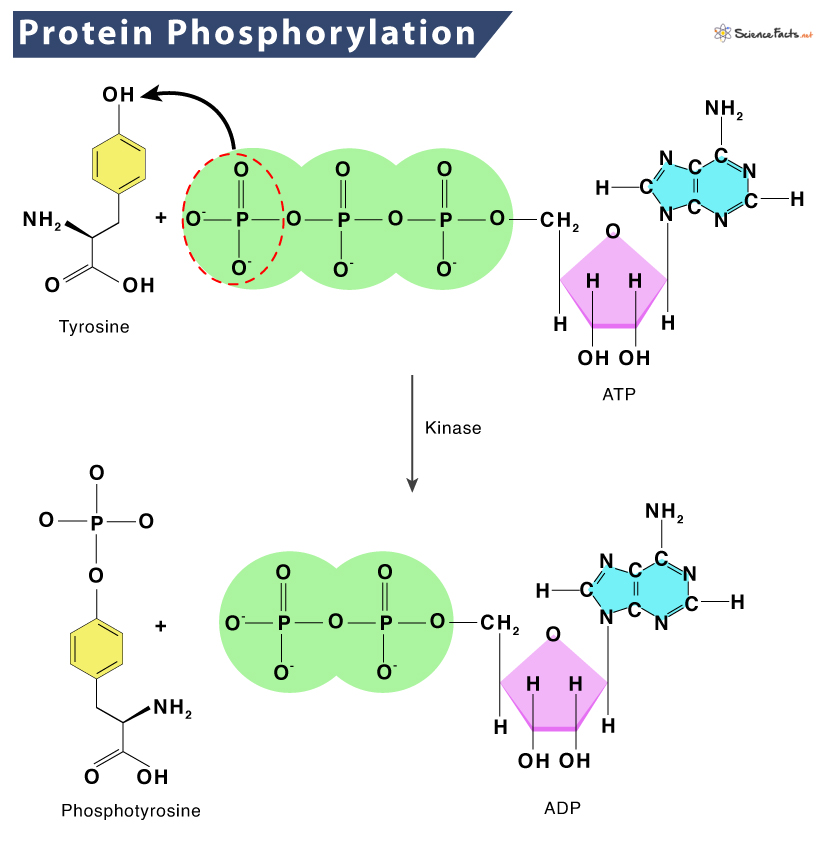Some common amino acids phosphorylated are tyrosine, serine, and threonine in eukaryotes and also histidine in prokaryotes. Recently, other amino acids such as arginine, lysine, aspartic acid, glutamic acid, and cysteine are also phosphorylated in humans. Protein phosphorylation was first accounted for in 1906 by Phoebus Levene in phosphorylated vitellin. However, almost 50 years later, phosphorylation by protein kinases was discovered.
Examples of Protein Phosphorylation
How do Protein Kinases Phosphorylate
What Roles Can Phosphorylation Play in Protein Function
The catalytic domain of protein kinase has one N- and a C-terminal subdomain, connected by a peptide strand, forming an active site with a front catalytic pocket and a back pocket. The catalytic domain is activated through the phosphorylation of the activation loop or an allosteric mechanism. The kinases also have non-catalytic domains where substrates bind and recruit other signaling proteins.
Mechanism of Protein Phosphorylation
The amino acids undergoing modification have a nucleophilic hydroxyl (-OH) group that attacks the terminal γ-phosphate (PO32-) of ATP. Thus, As a result, the phosphate group gets transferred to the amino acid side chain forming the phosphoprotein. For example, the phosphorylation of tyrosine forms phosphotyrosine. Magnesium ions facilitate this transfer, releasing a large amount of free energy when the phosphate–phosphate bond in ATP is broken. This addition makes the protein hydrophilic polar from hydrophobic apolar, allowing the protein to change conformation when interacting with other molecules. During the addition of the phosphate group, the nature of the bond formed varies greatly depending on the amino acid.
In amino acids serine, threonine, and tyrosine, it occurs through phosphodiester bond formationIn aspartic acid and glutamic acid, it happens through mixed anhydride linkagesIn histidine, lysine, and arginine, it occurs through phosphoramidite bonds
There are several ways in which phosphorylating a protein affects the functioning of that protein:
1. Acting as a Molecular Switch
The activation of protein kinase B through phosphorylation of its Ser and Thr residues regulates cell survival.
2. Regulating Signaling Pathways
Temporary protein-protein interaction helps to regulate many signaling pathways. A typical example is glomerular podocyte protein nephrin 1 (Neph1), which on phosphorylation interacts with an adaptor protein involved, thus activating a cascade of signaling pathways. In addition, the phosphorylation of a protein regulates signal transduction since it stimulates the subcellular translocation of the phosphorylated protein. The phosphorylation of serine/threonine-protein kinase (Ser350) residue of the death-associated protein (DAP) causes translocation from the cytoplasm to the nucleus of the protein, apoptosis-inducing kinase 2 (DRAK2).
3. Production and Recycling of ATP
The formation of ATP occurs through site-specific phosphorylation of ADP. It supplies the cell with the energy required to perform all cellular activities.
4. Therapeutic Functions
Protein phosphorylation is now a central focus of drug discovery due to the identification of therapeutic targets like protein kinases, protein phosphatases, and the binding domains of phosphoproteins.
